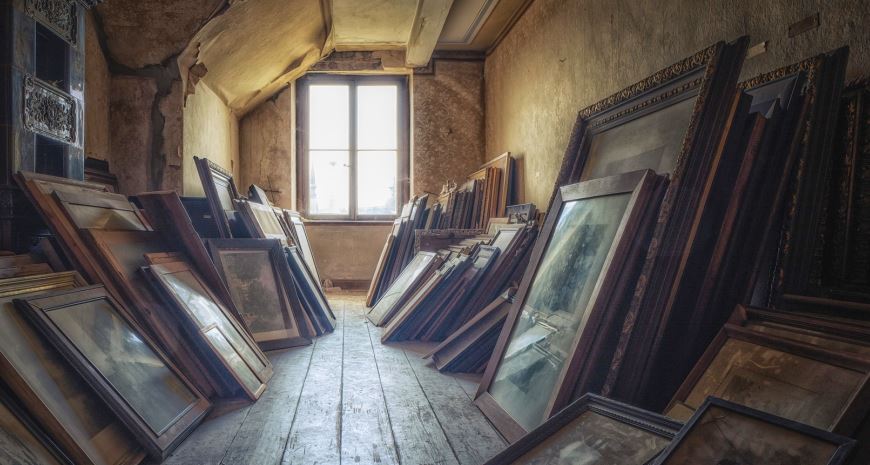Our clients often ask us advice on the best ways to protect and preserve the art they purchase from our website. Artalistic unveils the best was to clean a painting, shares tips for optimal storage conditions and ways to safely display your art while protecting it.
Art preservation – how to store paintings without damaging them
In order to protect a work of art - in particular paintings - the question of storage should not be taken lightly.
Handle with care
Top Tip: if you are going to handle a work of art, it is imperative that you keep your hands clean so as not to leave any marks on the work. Washing your hands with soap is important even if you plan on wearing archival quality protective cotton gloves. Be sure to pick up the piece with both hands at all times so that you don’t accidentally drop it.
Art conservation tips for pieces you wish to display
Making sure that the space you display your artwork in meets optimal preservation requirements is essential for preserving art. There is a certain Goldilocks zone of heat and humidity that is best for art conservation. The temperature of the room should ideally be between 64°F and 68°F (18°C - 20°C). The humidity level should be between 50% and 60%. Paintings begin to deteriorate when the humidity level of the room goes over 60%. Paintings hate hot weather. It is a good rule of thumb to keep the work of art in a room that is controlled by a thermostat to ensure the room stays within the suggested temperature range. If the room’s natural humidity level is not optimal, you should try to invest in a humidifier/dehumidifier or add a few decorative plants.
Protecting a painting from light
Paintings are especially susceptible to damage from UV light, which causes irreparable damage. The sun’s rays can penetrate deep into the different layers of the painting and may cause irreversible damage. Watercolors, engravings and drawings are particularly sensitive to light.
If you would like to display your piece under lights opt for indirect lighting and use incandescent or tungsten lights. Avoid shining the light directly on the work of art. You can bounce a light off of a nearby wall or ceiling to achieve softer lighting that will also preserve your art.
There is a reason museums don’t allow flash photography – it is very harmful to paintings. So if you are going to take a photograph of your work of art be sure to turn off your flash.
Storing artwork
If you do not want to put your art on display you can store it using an art rack like those used in museums. This is the best way to preserve art when in storage and many of these racks have wheels so they can be easily moved.
If you do not want to invest in a storage rack be sure to lay paintings flat in a place that will not collect dust. Drawings and photographs can be stored in a cardboard box or a box that is not airtight so that air can circulate around the piece and prevent mold from growing. For optimal protection you can place archival grade paper between each piece. Photographs can also be stored in protective plastic sleeves then stacked in a box.
Cleaning a painting
Can I clean a painting myself?
Quick Tip: If your painting is old, valuable or has great sentimental value to you - don't try and clean it yourself!
Don't take any risks, you will be happier in the long run if you entrust it to a painting specialist or restorer.
If your piece does not meet the above criteria and you feel confident about trying to clean it yourself, here are a few tips to help you clean your painting depending on the media used to create it.
Cleaning an oil painting
You can carefully dust off the back of the painting with a brush or a paintbrush. A small vacuum cleaner set at low speed can also help remove dust from the frame. Never use water as this may cause the canvas to come off the frame!
For the front of the painting, a cotton or microfiber cloth lightly soaked in distilled water or mineral water mixed with basic household soap (Marseille soap) works well. Use slow delicate circular motions. The painting will immediately appear less dull.
Cleaning acrylic paintings
Acrylic paintings are generally not varnished. Proceed with caution and find a professional well versed in cleaning acrylic paintings.
How NOT to clean a painting!
Never use solvents or alcohol-based products to clean your paintings as this will lead to disaster! Don’t attempt any old wives’ tale methods like rubbing the painting with an onion or potato, as this will slowly remove the paint over time.
We hope that our advice on how to preserve art and clean paintings was helpful. You now have all of the tools to keep the piece you purchased from our carefully curated gallery of paintings, sculptures, photographs, drawings and limited edition prints in mint condition! Feel free to contact our team of experts if you are an artist looking to create an online portfolio or are looking for advice about investing in fine art. Thank you, stay safe and see you soon for the latest news from the art world!
 English
English Français
Français


You must be logged in to post a comment.
Click here to log in